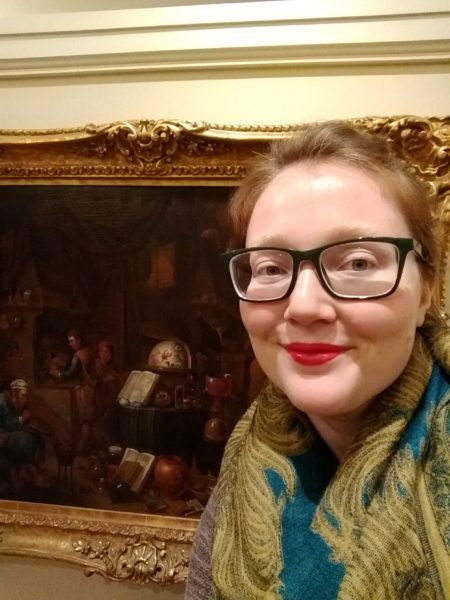
(Photograph courtesy of Dr. Elisabeth Berry Drago, and used with permission.)
Say the word “alchemy”. What comes to mind?
If you thought of a bearded recluse trying to transmute lead into gold–well, that’s not really accurate, says Dr. Elisabeth Berry Drago.
Podcast: Play in new window | Download
Subscribe: RSS
Lisa, as she prefers to be called, is an artist, art historian and Public History Fellow at Philadelphia’s Science History Institute. One of her specialties is creating content that puts visitors into the stories her research uncovers. Often, those stories are about the ways art and technology have worked together in society.
Recently, Lisa curated the Institute’s exhibition, “Age of Alchemy”, which is just one of a series of alchemy-inspired projects. She’s also creating content for a new digital game which puts players in the middle of a seventeenth-century alchemy lab. “Age of Alchemy: The Goldsmith’s Daughter” is based on some of the paintings of that era. Lisa says the game is currently in prototype stage, with a projected release date of 2019.
Alchemy, Lisa explains, was the foundation for today’s studies in chemistry. Far from being reclusive, alchemists worked in communities–that were much more diverse than the European paintings might have us believe. At the heart of these communities were artists, for whom alchemy resulted in some innovations of color, technique and materials.
And you won’t believe some of the stories of the colorful characters in the seventeenth-century labs.
Lisa talked about her background, some of the ways science and art historically intersected through alchemy, and the parallels with today’s artists for whom science and technology are a means of creating new work.
On this edition of Over Coffee® you will hear:
-
How her early experiences first sparked Lisa’s creativity as an artist;
-
What first led her to realize the connection between science and art;
-
The work experiences that underscored her interest in combining art and technology;
-
How alchemy served as a precursor to modern science–and its parallel with artists’ work
-
Some little-known stories of artists who used alchemy as a springboard to come up with some surprising innovations;
-
How some current STEAM initiatives parallel the art-science intersection of the seventeenth century;
-
Some of the myths debunked by “Age of Alchemy”–and the facts behind commonly-held beliefs
-
Profiles of some of the alchemists of the time (including a story of one who might surprise you!)
-
Several of the STEAM resources that could result in more women and girls “entering the room” to work in science and technology;
-
How one of the programs at the Science History Institute engaged and inspired a young girl, possibly enabling her to envision a future career;
-
A preview of some scheduled new programs coming up in September at the Science History Institute, which are geared to include everyone;
-
The story of “Age of Alchemy: The Goldsmith’s Daughter”, a new immersive digital game currently in development at the Science History Institute.
